Rowing (sport)
Rowing, sometimes referred to as crew in the United States,[1] is a sport whose origins reach back to Ancient Egyptian times. It involves propelling a boat (racing shell) on water using oars. By pushing against the water with an oar, a force is generated to move the boat. The sport can be either recreational for enjoyment or fitness, or competitive, when athletes race against each other in boats. The training and physical strain on the body required to be a successful rower is intense. A very tough mind and body is needed to succeed.[2] There are a number of different boat classes in which athletes compete, ranging from an individual shell (called a single scull) to an eight-person shell with a coxswain (called a coxed eight).
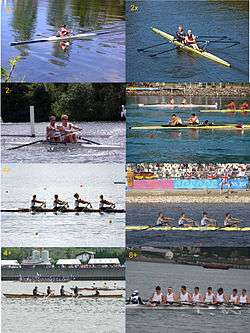 Eight classes of racing boats, six of which are part of the Summer Olympic Games. | |
| Highest governing body | International Rowing Federation (FISA) |
|---|---|
| Nicknames | Crew |
| First modern-day competition | 1715 [note 1] |
| Characteristics | |
| Contact | No |
| Team members | 1, 2, 3, 4, 5 or 9 (depending on boat class and whether there is a coxswain) |
| Mixed gender | Separate competitions |
| Type | Water sport, outdoor |
| Equipment | Racing shell, oars |
| Venue | River, artificial lake, canal, ocean |
| Glossary | Glossary of rowing terms |
| Presence | |
| Olympic | since 1900 (men only); since 1976 (both men and women) |
| Paralympic | 2008 |
| World Games | Indoor: 2017 |
Modern rowing as a competitive sport can be traced to the early 17th century when races (regattas) were held between professional watermen on the River Thames in London, United Kingdom. Often prizes were offered by the London Guilds and Livery Companies. Amateur competition began towards the end of the 18th century with the arrival of "boat clubs" at the British public schools of Eton College, Shrewsbury School, Durham School, and Westminster School. Similarly, clubs were formed at the University of Oxford, with a race held between Brasenose College and Jesus College in 1815. At the University of Cambridge the first recorded races were in 1827. Public rowing clubs were beginning at the same time; in England Leander Club was founded in 1818, in Germany Der Hamburger und Germania Ruder Club was founded in 1836 and in the United States Narragansett Boat Club was founded in 1838 and Detroit Boat Club was founded in 1839. In 1843, the first American college rowing club was formed at Yale University.
The International Rowing Federation (French: Fédération Internationale des Sociétés d'Aviron, abbreviated FISA), responsible for international governance of rowing, was founded in 1892 to provide regulation at a time when the sport was gaining popularity. Across six continents, 150 countries now have rowing federations that participate in the sport.[3]
Rowing is one of the oldest Olympic sports. Though it was on the programme for the 1896 games, racing did not take place due to bad weather.[4] Male rowers have competed since the 1900 Summer Olympics. Women's rowing was added to the Olympic programme in 1976. Today, there are fourteen boat classes which race at the Olympics.[5]
Each year the World Rowing Championships are staged by FISA with 22 boat classes that race. In Olympic years, only the non-Olympic boat classes are raced at the World Championships. The European Rowing Championships are held annually, along with three World Rowing Cups in which each event earns a number of points for a country towards the World Cup title. Since 2008, rowing has also been competed at the Paralympic Games.
Major domestic competitions take place in dominant rowing nations and include The Boat Race and Henley Royal Regatta in the United Kingdom, the Australian Rowing Championships in Australia, the Harvard–Yale Regatta and Head of the Charles Regatta in the United States, and Royal Canadian Henley Regatta in Canada. Many other competitions often exist for racing between clubs, schools, and universities in each nation.
Basic information
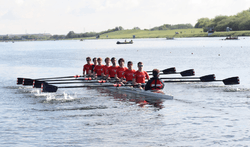
While rowing, the athlete sits in the boat facing toward the stern, and uses the oars which are held in place by the oarlocks to propel the boat forward (towards the bow). This may be done on a canal, river, lake, sea, or other large bodies of water. The sport requires strong core balance, physical strength, flexibility, and cardiovascular endurance.[6]
Whilst the action of rowing and equipment used remains fairly consistent throughout the world, there are many different types of competition. These include endurance races, time trials, stake racing, bumps racing, and the side-by-side format used in the Olympic games. The many different formats are a result of the long history of the sport, its development in different regions of the world, and specific local requirements and restrictions.
There are two forms of rowing:
- In sweep or sweep-oar rowing, each rower has one oar, held with both hands.[7] This is generally done in pairs, fours, and eights. In some regions of the world, each rower in a sweep boat is referred to either as port or starboard, depending on which side of the boat the rower's oar extends to. In other regions, the port side is referred to as stroke side, and the starboard side as bow side; this applies even if the stroke oarsman is rowing on bow side and/or the bow oarsman on stroke side.
- In sculling each rower has two oars (or sculls), one in each hand. Sculling is usually done without a coxswain, in quads, doubles or singles. The oar in the sculler's right hand extends to port, and the oar in the left hand extends to starboard.
Anatomy of a stroke
The rowing stroke may be characterized by three fundamental reference points. The catch, which is placement of the oar blade in the water, the drive, which is the part of the stoke where one pulls on the oar, and the extraction, also known as the finish or release, when the rower removes the oar blade from the water. The action between catch and release is the first phase of the stroke that propels the boat.
At the catch the rower places the blade in the water and applies pressure to the oar by pushing the seat toward the bow of the boat by extending the legs, thus pushing the boat through the water. The point of placement of the blade in the water is a relatively fixed point about which the oar serves as a lever to propel the boat. As the rower's legs approach full extension, the rower pivots the torso toward the bow of the boat and then finally pulls the arms towards his or her chest. The hands meet the chest right above the diaphragm.
At the end of the stroke, with the blade still in the water, the hands drop slightly to unload the oar so that spring energy stored in the bend of the oar gets transferred to the boat, which eases removing the oar from the water and minimizes energy wasted on lifting water above the surface (splashing).
The recovery phase follows the drive. The recovery starts with the extraction and involves coordinating the body movements with the goal to move the oar back to the catch position. In extraction, the rower pushes down on the oar handle to quickly lift the blade from the water and rapidly rotates the oar so that the blade is parallel to the water. This process is sometimes referred to as feathering the blade. Simultaneously, the rower pushes the oar handle away from the chest. The blade emerges from the water square and feathers immediately once clear of the water. After feathering and extending the arms, the rower pivots the body forward. Once the hands are past the knees, the rower compresses the legs which moves the seat towards the stern of the boat. The leg compression occurs relatively slowly compared to the rest of the stroke, which affords the rower a moment to recover, and allows the boat to glide through the water. The gliding of the boat through the water during recovery is often called run.
A controlled slide is necessary to maintain momentum and achieve optimal boat run. However, various teaching methods disagree about the optimal relation in timing between drive and recovery. Near the end of the recovery, the rower squares the blade into perpendicular orientation with respect to the water, and begins another stroke.[2][8]
Breathing during a rowing stroke
There are two schools of thought with respect to the appropriate breathing technique during the rowing motion: Full lungs at the catch and empty lungs at the catch.
With the full lung technique, rowers exhale during the stroke and inhale during the recovery. In laboured circumstances, rowers will take a quick pant at the end of the stroke before taking a deep breath on the recovery that fills the lungs by the time the catch is reached.
In the empty-lung technique, rowers inhale during the drive, and exhale during the recovery so that they have empty lungs at the catch. Because the knees come up to the chest when the lungs are empty, this technique allows the rower to reach a little bit further than if the lungs were full of air. Full lungs at the release also can help the rower to maintain a straighter back, a style encouraged by many coaches.
A scientific study of the benefits of entrained breathing technique in relatively fit, but untrained, rowers did not show any physiological or psychological benefit to either technique.[9]
Rowing propulsion
Rowing is a cyclic (or intermittent) form of propulsion such that in the quasi-steady state the motion of the system (the system comprising the rower, the oars, and the boat), is repeated regularly. In order to maintain the steady-state propulsion of the system without either accelerating or decelerating the system, the sum of all the external forces on the system, averaged over the cycle, must be zero. Thus, the average drag (retarding) force on the system must equal the average propulsion force on the system. The drag forces consist of aerodynamic drag on the superstructure of the system (components of the boat situated above the waterline), as well as the hydrodynamic drag on the submerged portion of the system. The propulsion forces are the forward reaction of the water on the oars while in the water. The oar can be used to provide a drag force (a force acting against the forward motion) when the system is brought to rest.
Although the oar can be conveniently thought of as a lever with a "fixed" pivot point in the water, the blade moves sideways and sternwards through the water, so that the magnitude of the propulsion force developed is the result of a complex interaction between unsteady fluid mechanics (the water flow around the blade) and solid mechanics and dynamics (the handle force applied to the oar, the oar's inertia and bending characteristic, the acceleration of the boat and so on).
Distinction from other watercraft
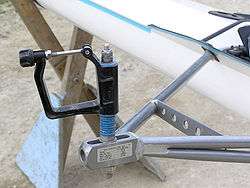
The distinction between rowing and other forms of water transport, such as canoeing or kayaking, is that in rowing the oars are held in place at a pivot point that is in a fixed position relative to the boat, this point is the load point for the oar to act as a second class lever (the blade fixed in the water is the fulcrum). In flatwater rowing, the boat (also called a shell or fine boat) is narrow to avoid drag, and the oars are attached to oarlocks ( also called gates ) at the end of outriggers extending from the sides of the boat.[10] Racing boats also have sliding seats to allow the use of the legs in addition to the body to apply power to the oar.
Fitness and health
Rowing is one of the few non-weight bearing sports that exercises all the major muscle groups, including quads, biceps, triceps, lats, glutes and abdominal muscles.[11] The sport also improves cardiovascular endurance and muscular strength. High-performance rowers tend to be tall and muscular:[12] although extra weight does increase the drag on the boat, the larger athletes' increased power tends to be more significant. The increased power is achieved through increased length of leverage on the oar through longer limbs of the athlete. In multi-person boats (2,4, or 8), the lightest person typically rows in the bow seat at the front of the boat.
Rowing is a low impact sport with movement only in defined ranges, so twist and sprain injuries are rare. However, the repetitive rowing action can put strain on knee joints, the spine and the tendons of the forearm, and inflammation of these are the most common rowing injuries.[13] If one rows with poor technique, especially rowing with a curved rather than straight back, other injuries may surface, including back pains. Blisters occur for almost all rowers, especially in the beginning of one's rowing career, as every stroke puts pressure on the hands, though rowing frequently tends to harden hands and generate protective calluses. Holding the oars too tightly or making adjustments to technique may cause recurring or new blisters, as it is common to feather the blade (previously described). Another common injury is getting "track bites", thin cuts on the back of one's calf or thigh caused by contact with the seat tracks at either end of the stroke.
History
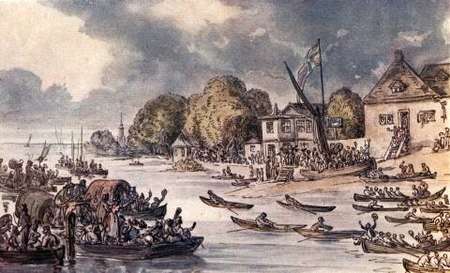
Ever since the earliest recorded references to rowing, the sporting element has been present. An Egyptian funerary inscription of 1430 BC records that the warrior Amenhotep (Amenophis) II was also renowned for his feats of oarsmanship. In the Aeneid, Virgil mentions rowing forming part of the funeral games arranged by Aeneas in honour of his father.[14] In the 13th century, Venetian festivals called regata included boat races among others.[15]
The first known "modern" rowing races began from competition among the professional watermen in the United Kingdom that provided ferry and taxi service on the River Thames in London. Prizes for wager races were often offered by the London Guilds and Livery Companies or wealthy owners of riverside houses.[14] The oldest surviving such race, Doggett's Coat and Badge was first contested in 1715 and is still held annually from London Bridge to Chelsea.[16] During the 19th century these races were to become numerous and popular, attracting large crowds. Prize matches amongst professionals similarly became popular on other rivers throughout Great Britain in the 19th century, notably on the Tyne. In America, the earliest known race dates back to 1756 in New York, when a pettiauger defeated a Cape Cod whaleboat in a race.[17]
Amateur competition in England began towards the end of the 18th century. Documentary evidence from this period is sparse, but it is known that the Monarch Boat Club of Eton College and the Isis Club of Westminster School were both in existence in the 1790s. The Star Club and Arrow Club in London for gentlemen amateurs were also in existence before 1800. At the University of Oxford bumping races were first organised in 1815 when Brasenose College and Jesus College boat clubs had the first annual race[18] while at Cambridge the first recorded races were in 1827.[19] Brasenose beat Jesus to win Oxford University's first Head of the River; the two clubs claim to be the oldest established boat clubs in the world. The Boat Race between Oxford University and Cambridge University first took place in 1829, and was the second intercollegiate sporting event (following the first Varsity Cricket Match by 2 years). The interest in the first Boat Race and subsequent matches led the town of Henley-on-Thames to begin hosting an annual regatta in 1839.[20]
Founded in 1818, Leander Club is the world's oldest public rowing club.[21] The second oldest club which still exists is the Der Hamburger und Germania Ruder Club which was founded 1836 and marked the beginning of rowing as an organized sport in Germany.[22] During the 19th century, as in England, wager matches in North America between professionals became very popular attracting vast crowds. Narragansett Boat Club was founded in 1838 exclusively for rowing. During an 1837 parade in Providence, R.I, a group of boatmen were pulling a longboat on wheels, which carried the oldest living survivor of the 1772 Gaspee Raid. They boasted to the crowd that they were the fastest rowing crew on the Bay. A group of Providence locals took issue with this and challenged them to race, which the Providence group summarily won. The six-man core of that group went on in 1838 to found NBC.[23] Detroit Boat Club was founded in 1839 and is the second oldest continuously-operated rowing club in the U.S. In 1843, the first American college rowing club was formed at Yale University.[24] The Harvard–Yale Regatta is the oldest intercollegiate sporting event in the United States,http://rowinghistory.net/Time%20Line/TL%20-1849images.htm[25] having been contested every year since 1852 (excepting interruptions for wars).
The Schuylkill Navy is an association of amateur rowing clubs of Philadelphia. Founded in 1858, it is the oldest amateur athletic governing body in the United States.[26] The member clubs are all on the Schuylkill River where it flows through Fairmount Park in Philadelphia, mostly on the historic Boathouse Row. The success of the Schuylkill Navy and similar organizations contributed heavily to the extinction of professional rowing and the sport's current status as an amateur sport.[27] At its founding, it had nine clubs; today, there are 12. At least 23 other clubs have belonged to the Navy at various times. Many of the clubs have a rich history, and have produced a large number of Olympians and world-class competitors.[29]
FISA
The sport's governing body is formally known as the "Fédération Internationale des Sociétés d'Aviron" (English translation: International Federation of Rowing Associations), though, the majority of the time, either the initialism "FISA" or the English co-name, World Rowing, which the organization "uses for 'commercial purposes,'"[30] is used to refer to it. Founded by representatives from France, Switzerland, Belgium, Adriatica (now a part of Italy), and Italy in Turin on 25 June 1892,[31] FISA is the oldest international sports federation in the Olympic movement.[32]
FISA first organized a European Rowing Championships in 1893.[31] An annual World Rowing Championships was introduced in 1962.[25][33] Rowing has also been conducted at the Olympic Games since 1900 (cancelled at the first modern Games in 1896 due to bad weather).[34]
Equipment
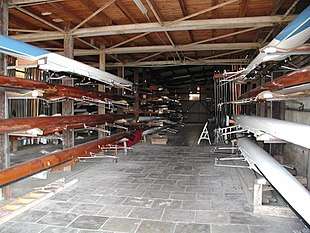
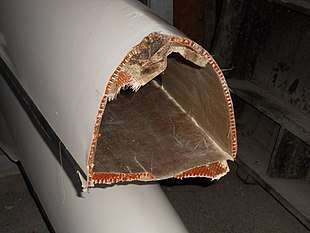
Racing boats (often called shells) are long, narrow, and broadly semi-circular in cross-section in order to reduce drag to a minimum. There is some trade off between boat speed and stability in choice of hull shape. They usually have a fin towards the rear, to help prevent roll and yaw and to increase the effectiveness of the rudder.
Originally made from wood, shells are now almost always made from a composite material (usually a double skin of carbon-fibre reinforced plastic with a sandwich of honeycomb material) for strength and weight advantages. FISA rules specify minimum weights for each class of boat so that no individual team will gain a great advantage from the use of expensive materials or technology.
There are several different types of boats. They are classified using:
- Number of rowers. In all forms of modern competition the number is either 1, 2, 4, or 8.
- Position of coxswain (also referred to as cox). Boats are either coxless (straight), bow-coxed (also called bowloaders), or stern-coxed.
Although sculling and sweep boats are generally identical to each other (except having different riggers), they are referred to using different names:
- Sweep: coxless pair (or straight pair) (2-), coxed pair (2+), Coxless four (or straight four) (4-), coxed four (4+), eight (8+) (always coxed)
- Sculling: single scull (1x), double scull (2x), triple scull (3x) (very rare), quad (or quadruple) scull (4x), octuple scull (8x) (always coxed, and mainly for juniors and exhibition)
- Sweep/Sculling: Queep, 2 scullers and 2 sweepers (very rare) Randan
With the smaller boats, specialist versions of the shells for sculling can be made lighter. The riggers in sculling apply the forces symmetrically to each side of the boat, whereas in sweep oared racing these forces are staggered alternately along the boat. The sweep oared boat has to be stiffer to handle these unmatched forces, so consequently requires more bracing and is usually heavier – a pair (2-) is usually a more robust boat than a double scull (2x) for example, and being heavier is also slower when used as a double scull. In theory this could also apply to the 4x and 8x, but most rowing clubs cannot afford to have a dedicated large hull which might be rarely used and instead generally opt for versatility in their fleet by using stronger shells which can be rigged for either sweep rowing or sculling. The symmetrical forces also make sculling more efficient than rowing: the double scull is faster than the coxless pair, and the quadruple scull is faster than the coxless four.
One additional boat is the queep, a coxed or non-coxed shell. The bow and stroke positions have a set of sculling riggers and two and three have a sweep set. These shells have been used in the UK and recently at a club in Victoria BC, Canada.
Many adjustments can be made to the equipment to accommodate the physiques of the crew. Collectively these adjustments are known as the boat's rigging.
Steering
Single, and double sculls are usually steered by the scullers pulling harder on one side or the other. In other boats, there is a rudder, controlled by the coxswain, if present, or by one of the crew. In the latter case, the rudder cable is attached to the toe of one of his shoes which can pivot about the ball of the foot, moving the cable left or right. The bowman may steer since he has the best vision when looking over his shoulder. On straighter courses, the strokesman may steer, since he can point the stern of the boat at some landmark at the start of the course. On international courses, landmarks for the steersmen, consisting of two aligned poles, may be provided.

Blades
Blades, otherwise known as oars to amateurs or non-rowers, are used to propel the boat. They are long (sculling: 250–300 cm; sweep oar: 340–360 cm) poles with one flat end about 50 cm long and 25 cm wide, called the blade. Classic blades were made out of wood, but modern blades are made from more expensive and durable synthetic material, the most common being carbon fiber.
An 'oar' is often referred to as a blade in the case of sweep oar rowing and as a scull in the case of sculling. A sculling oar is shorter and has a smaller blade area than the equivalent sweep oar. The combined blade area of a pair of sculls is however greater than that of a single sweep oar, so the oarsman when sculling is working against more water than when rowing sweep-oared. He is able to do this because the body action in sculling is more anatomically efficient (due to the symmetry).
The spoon of oars is normally painted with the colours of the club to which they belong. This greatly simplifies identification of boats at a distance. As many sports teams have logos printed on their jerseys, rowing clubs have specifically painted blades that each team is associated with.
Indoor rowing
Indoor rowing (on ergometer, or tank) is a way to train technique and strength by going through the same motions as rowing, with resistance. Indoor rowing is helpful when there are no rowable bodies of water near by, or weather conditions don't permit rowing.
Rowing tank
A rowing tank is an indoor facility which attempts to mimic the conditions rowers face on open water. Rowing tanks are primarily used for off-season rowing, muscle specific conditioning and technique training, or simply when bad weather doesn't allow for open water training.
Ergometer
Ergometer rowing machines (colloquially ergs or ergo) simulate the rowing action and provide a means of training on land when waterborne training is restricted, and of measuring rowing fitness. Ergometers do not simulate the lateral balance challenges, the exact resistance of water, or the exact motions of true rowing including the sweep of the oar handles. For that reason ergometer scores are generally not used as the sole selection criterion for crews (colloquially "ergs don't float"), and technique training is limited to the basic body position and movements. However, this action can still allow a comparable workout to those experienced on the water.
Sometimes, slides are placed underneath the erg to try to simulate the movement of being on the water. It allows the machine to move back and forth smoothly as if there is water beneath you. The slides can be connected in rows or columns so that rowers are forced to move together on the ergometer, similar to how they would match up their rhythm in a boat.
Indoor rowing has become popular as a sport in its own right with numerous indoor competitions (and the annual World Championship CRASH-B Sprints in Boston) during the winter off-season.[35]
One of the most common brand of ergometers is Concept2.[36] The company offers multiple types of models, including the Model D, Model E, and the dynamic rower. An updated Rowperfect brand of dynamic rowers, RP3, produces ergometers that more naturally mimic the feel and resistance of rowing in a shell on the water. It additionally, shows a dynamic force curve of power that provides the rower with detailed information about their stroke which they can use to improve technique and get stronger.[37]
Damage
The most commonly damaged piece of rowing equipment is the skeg, which is a metal or plastic fin that comes out of the bottom of the boat to help maintain stability, and to assist in steering. Since the skeg sticks out below the hull of the boat it is the most vulnerable to damage, however it is relatively easy to replace skegs by gluing a new one on. Hull damage is also a significant concern both for maintaining equipment, and for rower safety. Hull damage can be caused by submerged logs, poor strapping to trailers, and collisions with other boats, docks, rocks, etc.
Transportation
Boats are conveyed to competitions on special trailers accommodating up to 20 boats.
Boat storage, boat houses, and boat centers
Racing boats are stored in boat houses. These are specially designed storage areas which usually consist of a long two-story building with a large door at one end which leads out to a pontoon or slipway on the river or lakeside. The boats are stored on racks (horizontal bars, usually metal) on the ground floor. Oars, riggers, and other equipment is stored around the boats. Boat houses are typically associated with rowing clubs and include some social facilities on the upper floor: a cafe, bar, or gym.
Competition
Rowers may take part in the sport for their leisure or they may row competitively. There are different types of competition in the sport of rowing. In the U.S. all types of races are referred to as regattas whereas this term is only used in the UK for head-to-head or multi-lane races (such as those that take place at Dorney Lake), which generally take place in the summer season. Time trials occur in the UK during the winter, and are referred to as Head races. In the US, head races (usually about 5k, depending on the body of water) are rowed in the fall, while 2k sprint races are rowed in the spring and summer.
Rowing is unusual in the demands it places on competitors. The standard world championship race distance of 2,000 metres is long enough to have a large endurance element, but short enough (typically 5.5 to 7.5 minutes) to feel like a sprint. This means that rowers have some of the highest power outputs of athletes in any sport.[38] At the same time the motion involved in the sport compresses the rowers' lungs, limiting the amount of oxygen available to them. This requires rowers to tailor their breathing to the stroke, typically inhaling and exhaling twice per stroke, unlike most other sports such as cycling where competitors can breathe freely.
Side by side
Most races that are held in the spring and summer feature side by side racing, or sprint racing, sometimes called a regatta; all the boats start at the same time from a stationary position and the winner is the boat that crosses the finish line first. The number of boats in a race typically varies between two (which is sometimes referred to as a dual race) to eight, but any number of boats can start together if the course is wide enough.
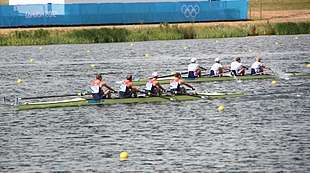
The standard length races for the Olympics and the World Rowing Championships is 2 kilometres (1.24 mi) long; 1.5 kilometres (0.93 mi) – 2 kilometres (1.24 mi) for US high school races on the east coast; and 1,000 m for masters rowers (rowers older than 27). However the race distance can and does vary from dashes or sprints, which may be 500 metres (1,640 ft) long, to races of marathon or ultra-marathon length races such as the Tour du Léman in Geneva, Switzerland which is 160 kilometres (99 mi),[39] and the 2 day, 185-kilometre (115 mi) Corvallis to Portland Regatta[40] held in Oregon, USA. In the UK, regattas are generally between 500 metres (1,640 ft) and 2 kilometres (1.24 mi) long.
A feature of the end of twentieth century rowing was the development of non-Olympic multiple crew racing boats, typically fixed seat-gigs, pilot boats and in Finland church- or longboats. The most usual craft in races held around the coasts of Britain during summer months is the Cornish pilot gig, most typically in the south-west, with crews of 6 from local towns and races of varying distances. The Cornish pilot gig was designed and built to ferry harbour and river pilots to and from ships in fierce coastal waters. The boat needed to be stable and fast with the large crew hence making it ideal for its modern racing usage. In Finland 14-oared church boats race throughout the summer months, usually on lakes, and often with mixed crews. The largest gathering sees over 7000 rowers mainly rowing the 60 kilometres (37 mi) course at Sulkava[41] near the eastern border over a long weekend in mid July. The weekend features the World Masters church boat event which also includes a 2 kilometres (1.24 mi) dash.[42]
Two traditional non-standard distance shell races are the annual Boat Race between Oxford and Cambridge and the Harvard-Yale Boat Race which cover courses of approximately 4 miles (6.44 km). The Henley Royal Regatta is also raced upon a non-standard distance at 2,112 meters (1 mile, 550 yards).
In general, multi-boat competitions are organized in a series of rounds, with the fastest boats in each heat qualifying for the next round. The losing boats from each heat may be given a second chance to qualify through a repechage. The World Rowing Championships offers multi-lane racing in heats, finals and repechages. At Henley Royal Regatta two crews compete side by side in each round, in a straightforward knock-out format, with no repechages.
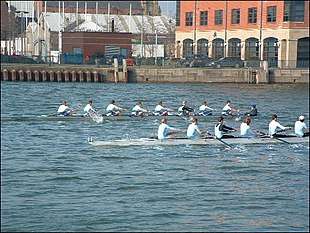
Head races
Head races are time trial / processional races that take place from autumn (fall) to early spring (depending on local conditions). Boats begin with a rolling start at intervals of 10 – 20 seconds, and are timed over a set distance. Head courses usually vary in length from 2,000 metres (1.24 mi) to 12,000 metres (7.46 mi), though there are longer races such as the Boston Rowing Marathon and shorter such as Pairs Head.
The oldest, and arguably most famous, head race is the Head of the River Race, founded by Steve Fairbairn in 1926 which takes place each March on the river Thames in London, United Kingdom. Head racing was exported to the United States in the 1950s, and the Head of the Charles Regatta held each October on the Charles River in Boston, Massachusetts, United States is now the largest rowing event in the world. The Head of the Charles, along with the Head of the Schuylkill in Philadelphia and the Head of the Connecticut, are considered to be the three "fall classics."[43]
These processional races are known as Head Races, because, as with bumps racing, the fastest crew is awarded the title Head of the River (as in "head of the class"). It was not deemed feasible to run bumps racing on the Tideway, so a timed format was adopted and soon caught on.
Time trials are sometimes used to determine who competes in an event where there is a limited number of entries, for example the qualifying races for Henley Royal Regatta, and rowing on and getting on for the Oxford and Cambridge Bumps races respectively.
Bumps races
A bumps race is a multi-day race beginning with crews lined up along the river at set intervals. They start simultaneously and all pursue the boat ahead while avoiding being bumped by a boat from behind. If a crew overtakes or makes physical contact with the crew ahead, a bump is awarded. As a result, damage to boats and equipment is common during bumps racing. To avoid damage the cox of the crew being bumped may concede the bump before contact is actually made. The next day, the bumping crew will start ahead of any crews that have been bumped. The positions at the end of the last race are used to set the positions on the first day of the races the next year. Oxford and Cambridge Universities hold bumps races for their respective colleges twice a year, and there are also Town Bumps races in both cities, open to non-university crews. Oxford's races are organised by City of Oxford Rowing Club[44] and Cambridge's are organised by the Cambridgeshire Rowing Association.
Stake races
The stake format was often used in early American races. Competitors line up at the start, race to a stake, moored boat, or buoy some distance away, and return. The 180° turn requires mastery of steering. These races are popular with spectators because one may watch both the start and finish. Usually only two boats would race at once to avoid collision. The Green Mountain Head Regatta continues to use the stake format but it is run as a head race with an interval start.[45] A similar type of racing is found in UK and Irish coastal rowing, where a number of boats race out to a given point from the coast and then return fighting rough water all the way. In Irish coastal rowing the boats are in individual lanes with the races consisting of up to 3 turns to make the race distance 2.3 km.
World Championships and Olympics
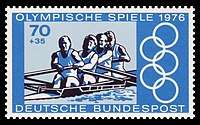
The Olympic Games are held every four years, where only select boat classes are raced (14 in total):
- Men: quad scull, double scull, single scull, eight, coxless four, and coxless pair
- Lightweight Men: double scull
- Women: quad scull, double scull, single scull, eight, coxless four, and coxless pair
- Lightweight Women: double scull
At the end of each year, the FISA holds the World Rowing Championships with events in 22 different boat classes. Athletes generally consider the Olympic classes to be premier events . In 2017 FISA voted to adopt a new Olympic programme for 2020, whereby the lightweight men's coxless four event was replaced by the women's heavyweight coxless four. This was done to ensure that rowing had a gender equal Olympic programme.[5] During Olympic years only non-Olympic boats compete at the World Championships.
Rules of racing
There are many differing sets of rules governing racing, and these are generally defined by the governing body of the sport in a particular country—e.g., British Rowing in England and Wales, Rowing Australia in Australia, and USRowing in the United States. In international competitions, the rules are set out by the world governing body, the Fédération Internationale des Sociétés d'Aviron (FISA). The rules are mostly similar but do vary; for example, British Rowing requires coxswains to wear buoyancy aids at all times, whereas FISA rules do not.
Rowing crew
Boat positions
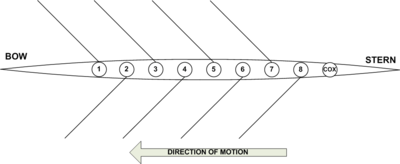
Rowers in multi-rower boats are numbered sequentially from the bow aft. The number-one rower is called the bowman, or just 'bow', whilst the rower closest to the stern is called the 'strokeman' or just 'stroke'. There are some exceptions to this – some UK coastal rowers, and in France, Spain, and Italy rowers number from stern to bow.
In addition to this, certain crew members have other titles and roles. In an 8+ the stern pair are responsible for setting the stroke rate and rhythm for the rest of the boat to follow. The middle four (sometimes called the "engine room" or "power house") are usually the less technical, but more powerful rowers in the crew, whilst the bow pair are the more technical and generally regarded as the pair to set up the balance of the boat. They also have most influence on the line the boat steers.
Coxswain
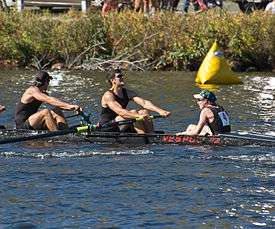
The coxswain (or simply the cox) is the member who sits in the boat facing the bow, steers the boat, and coordinates the power and rhythm of the rowers – by communicating to the crew through a device called a cox box and speakers. They usually sit in the stern of the boat, except in bowloaders where the coxswain lies in the bow. Bowloader are usually seen as the coxed four and coxed pair type of boat.
It is an advantage for the coxswain to be light, as this requires less effort for the crew to propel the boat. In many competitive events there is a minimum weight set for the coxswain to prevent unfair advantage.
- International (FISA) – 55 kilograms (121.25 lb) (Men's, U23 men's, junior men's boats), 50 kilograms (110.23 lb) (Women's, U23 women's, junior women's and mixed boats)[46]
- UK (British Rowing) – 55 kilograms (121.25 lb) (Open and mixed boats), 50 kilograms (110.23 lb) (Women's boats), 45 kilograms (99.21 lb) (J15 and younger boats)[47]
- US (USRowing) – 120 pounds (54 kg) (Men's boats), 110 pounds (50 kg) (Women's boats)[48]
If a coxswain is under the minimum weight allowance (underweight) they may have to carry weights in the boat such as sandbags.
Weight classes
In most levels of rowing there are different weight classes – typically "open" (or referred to as "heavyweight") and lightweight. Competitive rowing favours tall, muscular athletes due to the additional leverage height provides in pulling the oar through the water as well as the explosive power needed to propel the boat at high speed.
Heavyweight
Heavyweight rowers of both sexes tend to be very tall, broad-shouldered, have long arms and legs as well as tremendous cardiovascular capacity and low body fat ratios. Olympic or International level heavyweight male oarsmen are typically anywhere between 190 cm and 206 cm (6'3" to 6'9") tall with most being around 198 cm (6'6") and weighing approximately 102 kg (225 lb) with about 6 to 7% body fat.
Heavyweight women are slightly shorter at around 186 cm (6'1") and lighter than their male counterparts.
Some rowing enthusiasts claim that the disproportionate number of tall rowers is simply due to the unfair advantage that tall rowers have on the ergometer. This is due to the ergometer's inability to properly simulate the larger rowers drag on a boat due to weight. Since the ergometer is used to assess potential rowers, results on the ergometer machine play a large role in a rower's career success. Thus, many erg scores are weight-adjusted, as heavyweights typically find it easier to get better erg scores. Also, since crew selection has favored tall rowers long before the advent of the ergometer,[49][50] and bigger, taller crews are almost universally faster than smaller, shorter crews on the water, being tall is a definite advantage ultimately having little to do with the ergometer.
Lightweight
Unlike most other non-combat sports, rowing has a special weight category called lightweight (Lwt for short). According to FISA, this weight category was introduced "to encourage more universality in the sport especially among nations with less statuesque people". The first lightweight events were held at the World Championships in 1974 for men and 1985 for women. Lightweight rowing was added to the Olympics in 1996.
At international level the limits are:
- Men: Crew average 70 kg (154 lb) – no rower over 72.5 kg (160 lb)
- Women: Crew average 57 kilograms (125 lb) – no rower over 59 kg (130 lb)
The Olympic lightweight boat classes are limited to; Men's double (LM2x), Women's double (LW2x).
At the junior level (in the United States), regattas require each rower to weigh in at least two hours before their race; they are sometimes given two chances to make weight at smaller regattas, with the exception of older more prestigious regattas, which allow only one opportunity to make weight. For juniors in the United States, the lightweight cutoff for men is 150.0 lb.; for women, it is 130.0 lb. In the fall the weight limits are increased for women, with the cutoff being 135 lb.
At the collegiate level (in the United States), the lightweight weight requirements can be different depending on competitive season. For fall regattas (typically head races), the lightweight cutoff for men is 165.0 lb. and 135.0 lb. for women. In the spring season (typically sprint races), the lightweight cutoff for men is 160.0 lb., with a boat average of 155.0 lb. for the crew; for women, the lightweight cutoff is 130.0 lb.[51]
Women
Women row in all boat classes, from single scull to coxed eights, across the same age ranges and standards as men, from junior amateur through university-level to elite athlete.[52][53] Typically men and women compete in separate crews although mixed crews and mixed team events also take place.[54] Coaching for women is similar to that for men.[55] The world's first women's rowing team was formed in 1896 at the Furnivall Sculling Club in London.[56]
The first international women's races were the 1954 European Rowing Championships.[57] The introduction of women's rowing at the 1976 Summer Olympics in Montreal increased the growth of women's rowing because it created the incentive for national rowing federations to support women's events. Rowing at the 2012 Summer Olympics in London included six events for women compared with eight for men.[58] In the US, rowing is an NCAA sport for women but not for men;[59] though it is one of the country's oldest collegiate sports, the difference is in large part due to the requirements of Title IX.
At the international level, women's rowing traditionally has been dominated by Eastern European countries, such as Romania, Russia, and Bulgaria, although other countries such as Germany, Canada, the Netherlands, Great Britain and New Zealand often field competitive teams.[58] The United States also has had very competitive crews, and in recent years these crews have become even more competitive given the surge in women's collegiate rowing.[60] Now there is usually the same number of girls and boys in a group
Adaptive athletes
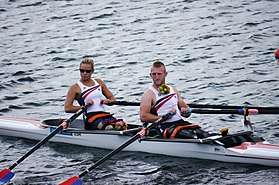
Adaptive rowing is a special category of races for those with physical disabilities. Under FISA rules there are 5 boat classes for adaptive rowers; mixed (2 men and 2 women plus cox) LTA (Legs, Trunk, Arms), mixed intellectual disability (2 men and 2 women plus cox) LTA (Legs, Trunk, Arms), mixed (1 man and 1 woman) TA (Trunk and Arms), and men's and women's AS (Arms and Shoulders). Events are held at the World Rowing Championships and were also held at the 2008 Summer Paralympics.[61]
Terminology and event nomenclature
Rowing events use a systematic nomenclature for the naming of events, so that age, gender, ability and size of boat can all be expressed in a few numbers and letters. The first letter to be used is 'L' or 'Lt' for lightweight. If absent then the crew is open weight. This can be followed by either a 'J' or 'B' to signify under 19 ("Junior") or under 23 years respectively. If absent the crew is open age (the letter 'O' is sometimes used). Next is either an 'M' or 'W' to signify if the crew are men or women. Then there is a number to show how many athletes are in the boat (1,2,4 or 8). An 'x' following the number indicates a sculling boat. Finally either a '+' or a '–' is added to indicate whether the boat is coxed or coxswainless.
Some events will use an experience rating to separate races. In the UK boats are classed as "Elite", "Senior", "Intermediate 1/2/3" or "Novice", depending on the number of wins the athletes have accumulated. Masters events use age ranges (represented by letters) to separate crews of older rowers. Mixed events are also held.
Examples:
- M8+ or 8+ men's eight (always coxed; sometimes written as 8o for "8-oared".)
- W4- women's coxless four
- LM2- lightweight men's coxless pair
- BM1x under-23 men's single sculls
- JW4x junior women's quad
- Masters WC2x masters women's double sculls with average crew age between 43–50
- Mixed Masters 8+ coxed eight with 4 women and 4 men as rowers and a coxswain of either gender
Sculling boat abbreviations and names:
| Boat abbreviation | Boat name |
|---|---|
| 1x | Single scull (or "Single" or "Scull") |
| 2x | Double scull |
| 4x | Coxless quadruple scull (or "Coxless quad" or "Quad") |
| 4x+ | Coxed quadruple scull ("Coxed quad") |
| 8x+ | Coxed octuple scull |
Rowing boat abbreviations and names:
| Boat abbreviation | Boat name |
|---|---|
| 2- | Coxless pair |
| 2+ | Coxed pair |
| 4- | Coxless four (or "Straight four") |
| 4+ | Coxed four |
| 8+ | Coxed eight ("Eight") |
See also
|
|
Further reading
- Halberstam, David (1985). The Amateurs: The Story of Four Young Men and Their Quest for an Olympic Gold Medal. Ballantine Books. ISBN 978-0-449-91003-0.
- Paintings of Thomas Eakins, a group of rowing scenes, first and most famous is Max Schmitt in a Single Scull (1871)
- Brown, Daniel James (2013). The Boys in the Boat: Nine Americans and Their Epic Quest for Gold at the 1936 Berlin Olympics. Penguin Books. ISBN 978-1-101-62274-2
References
Notes
- Doggett's Coat and Badge was first contested in 1715, rowing as a sport has recorded references back to Ancient Egyptian times.
Footnotes
- "Definition of CREW". www.merriam-webster.com. Archived from the original on 2016-08-02. Retrieved 2016-08-10.
- "Speed Rower, Competitive Rowing". Archived from the original on June 9, 2009. Retrieved 2009-02-05.
- "FISA - worldrowing.com". www.worldrowing.com. Archived from the original on 23 June 2017. Retrieved 6 June 2017.
- "International Olympic Committee – History of rowing at the Olympic games" (PDF). Archived (PDF) from the original on 8 September 2015. Retrieved 6 June 2017.
- "The Tokyo 2020 Olympic Games rowing programme announced". worldrowing.com. 12 June 2017. Archived from the original on 11 September 2019. Retrieved 11 September 2019.
- "Introduction" (PDF). Basic Rowing Physiology. Archived from the original (PDF) on 2006-11-10. Retrieved 2007-01-02.
- Garrett, William E.; Kirkendall, Donald T. (2000). Exercise and Sport Science. Lippincott Williams & Wilkins. ISBN 978-0-683-03421-9.
- "British Rowing Technique". The Amateur Rowing Association. Archived from the original on February 19, 2007. Retrieved 2006-12-23.
- Maclennan, Susan E.; Silestri, Gerard A.; Ward, Joseph; Mahler, Donald A., 1994. "Does entrained breathing improve the economy of rowing?" Medicine & Science in Sports & Exercise 26(5): 610–614.
- "Resistance". Basic Physics of Rowing. Archived from the original on 2007-01-24. Retrieved 2007-01-02.
- "Muscles Used". Concept2. Archived from the original on 21 May 2020. Retrieved 24 July 2020.
- "The Physical Characteristics of an Elite Rower". Setanta College. Retrieved 24 July 2020.
- Hosea, Timothy M.; Hannafin, Jo A. (26 April 2012). "Rowing Injuries". Sports Health: A Multidisciplinary Approach. 4 (3): 236–245. doi:10.1177/1941738112442484. PMC 3435926. PMID 23016093.
- Burnell, Richard; Page, Geoffrey (1997). The Brilliants: A History of the Leander Club. Leander Club. ISBN 978-0-9500061-1-6.
- "Online Etymology Dictionary". Archived from the original on 2007-10-15. Retrieved 2006-12-23.
- "Doggett's Coat & Badge Race". Guildhall Library Manuscripts Section. Archived from the original on 2006-09-28. Retrieved 2006-12-23.
- "Historical context of the beginnings of rowing at Penn". Archived from the original on 2008-08-08. Retrieved 2007-01-25.
- "A History of Oxford College Rowing". Archived from the original on 2007-04-10. Retrieved 2007-01-17.
- "The History of the Penn Athletic Club Rowing Association". Archived from the original on 2010-06-20. Retrieved 2007-01-17.
- Burnell, Richard (1989). Henley Royal Regatta: A celebration of 150 years. William Heinemann. ISBN 978-0-434-98134-2.
- "History - Leander Club". Leander Club. Archived from the original on 2013-03-23. Retrieved 2013-03-20.
- "Der Hamburger und Germania Ruder Club" (in German). Der Hamburger und Germania Ruder Club. Archived from the original on 2013-05-12. Retrieved 2013-03-20.
- Narragansett Boat Club: http://www.rownbc.org/?id=club-info/index Archived 2018-09-16 at the Wayback Machine
- "Archived copy". Archived from the original on 2013-03-20. Retrieved 2013-06-12.CS1 maint: archived copy as title (link)
- Veneziano, John. "America's Oldest Intercollegiate Athletic Event". Harvard University Boat Club. Archived from the original on 19 July 2011. Retrieved 2007-01-17.
- "Boathouse Row". Living Places. Archived from the original on 17 July 2011. Retrieved 30 April 2010.
- Moak, Jefferson (27 November 1983). "National Register of Historic Places Inventory—Nomination Form". NPS Focus, National Register of Historic Places, National Park Service, US Department of the Interior. p. 669. Archived from the original on 27 February 2014. Retrieved 7 May 2010.
- "Boathouse Row Clubs". Schuylkill Navy & Boathouse Row. Archived from the original on June 26, 2015. Retrieved June 26, 2015.
- Lyall, Sarah (2016-08-09). "Brazilians Speak Portuguese, but the Olympics Must Use French". The New York Times. ISSN 0362-4331. Archived from the original on 2016-08-11. Retrieved 2016-08-10.
- "Virtual Library of Sports: Rowing". Archived from the original on 2007-02-23. Retrieved 2007-01-17.
- "World Rowing". Archived from the original on 2007-01-02. Retrieved 2006-12-31.
- "Australian Rowing at the World Senior Championships". Archived from the original on 2013-06-14. Retrieved 2007-01-17.
- "Rowing Equipment and History". Archived from the original on 2011-11-02. Retrieved 2011-07-10.
- "Racing". Concept2.co.uk. Archived from the original on 2006-12-30. Retrieved 2007-01-02.
- "Home | Concept2". www.concept2.com. Archived from the original on 2017-01-26. Retrieved 2017-01-26.
- "Design of the RP3 | RP3 Rowing Machine". RP3 Rowing Machine. Archived from the original on 2017-02-02. Retrieved 2017-01-26.
- Longman, D.; Stock, J.T.; Wells, J.C.K. (2011). "Digit ratio (2D:4D) and rowing ergometer performance in males and females". American Journal of Physical Anthropology. 144 (3): 337–341. doi:10.1002/ajpa.21407. PMID 21302261.
- "Le Tour du Lac, Lake Geneva". explorerowing.org. Archived from the original on 2010-08-06. Retrieved 2013-03-18.
- "Corvallis to Portland Regatta (CPR)". newworldrowing.org. Archived from the original on 2007-05-17. Retrieved 2007-01-17.
- "Suursoudut". uursoudut.fi. Archived from the original on 2011-06-09. Retrieved 2011-03-26.
- "World Masters Rowing". wmrowing-sulkava.fi. Archived from the original on 2011-07-20. Retrieved 2011-03-26.
- "Schulten and Müller Complete Fall Domination". Independent Rowing News. 1 (2): 8. November 6, 1994. Archived from the original on January 2, 2014. Retrieved November 3, 2013.
- "Bumps". City of Oxford Rowing Club. Archived from the original on 2010-10-24. Retrieved 2011-01-20.
- "Green Mountain Head Regatta". Archived from the original on 2005-03-13. Retrieved 2007-01-27.
- "2010 FISA Rules of Racing – World Rowing". FISA. Archived from the original on 29 July 2013. Retrieved 19 March 2013.
- "2012 rules – British Rowing" (PDF). British Rowing. Archived (PDF) from the original on 31 August 2012. Retrieved 19 March 2013.
- "USRowing Rules of Rowing 2012". Archived from the original on 24 April 2012. Retrieved 19 March 2013.
- "Ben Spock Bio, Stats, and Results". Olympics at Sports-Reference.com. Archived from the original on 18 April 2020. Retrieved 6 June 2017.
- Buckhorn, Htbs Editor Göran R. (2 May 2011). "'Hear The Boat Sing': Ben Spock on 1924 Olympic Eight: Part 2 – Comparisons". Archived from the original on 18 July 2018. Retrieved 6 June 2017.
- "Women's Rowing 101 – PatriotLeague.org – Patriot League Official Athletic Site". PatriotLeague.org. 2008-04-18. Archived from the original on 2013-01-16. Retrieved 2013-03-20.
- "Rowing". World Rowing. Archived from the original on 10 April 2015. Retrieved 19 April 2015.
- "2015 World Rowing Championships". World Rowing. Archived from the original on 30 April 2015. Retrieved 19 April 2015."2014 World Rowing Championships". World Rowing. Archived from the original on 13 April 2015. Retrieved 19 April 2015.
- See for example, International Rowing Federation sections on World Rowing Masters Regatta and World Rowing Sprints
- "What makes a successful women's coach?". World Rowing. 8 December 2014. Archived from the original on 23 April 2015. Retrieved 19 April 2015.
- Ogilvie, Sarah (2012-11-01). Words of the World: A Global History of the Oxford English Dictionary. Cambridge University Press. ISBN 9781139789530.
- "Women in rowing". World Rowing. 23 February 2015. Archived from the original on 27 April 2015. Retrieved 19 April 2015.
- "Feature: the impact of Olympic inclusion on women's rowing". World Rowing. 12 June 2013. Archived from the original on 3 March 2016. Retrieved 19 April 2015.
- "College DI Rowing - Home - NCAA.com". NCAA.com. Archived from the original on 14 May 2016. Retrieved 6 June 2017.
- "For US women's eight, golden road begins in college". The Boston Globe. 21 October 2012. Archived from the original on 27 April 2015. Retrieved 19 April 2015.
- "Paralympic/Adaptive". WorldRowing.com. Archived from the original on 2006-07-14. Retrieved 2006-12-23.
External links and other sources
| Wikimedia Commons has media related to Rowing. |
- FISA — The Official World Rowing Website (See International Rowing Federation)
- River & Rowing Museum – Rowing Museum in Henley on Thames
- How Rowing Really Works
- The Physics of Rowing
- The maximum speed of rowing boats